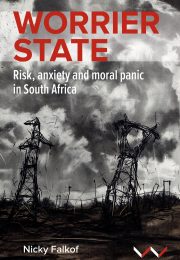
I am writing this review just a week after the terrible news came from the state of Uttar Pradesh in India that homes belonging to several Muslim protestors were demolished by the government. The reason? These individuals took to the streets to protest against ‘anti-Islamic’ remarks made by two members of the ruling party in India. Such instances are fairly common in the country. The nuances and details of this event are not a matter of discussion here but what I am pointing toward is a constant state of anxiety and panic that prevails in the country due to issues of religion, in a context defined by acute unemployment, poverty, and corruption- big and small. Nicky Falkof’s recently published book Worrier State: Risk, Anxiety, and Moral Panic in South Africa (Manchester University Press in 2022) is set in a completely different geographical location, that is South Africa, where a similar feeling of anxiety and moral panic persists.
The themes of the book can be prefaced in a broader context of race, class, gender, space, and identity and how these factors intertwine with one another to result in a pervasive culture of fear in South Africa. What I found most interesting about the book is how the author, a white citizen of the country, places herself reflexively in this context of crime, risk, lack of safety, racism, and gender violence. The book starts with several warnings that she has received from friends and family upon her return to her hometown Johannesburg. These warnings refer to the several risks of living in a crime-ridden, dangerous country like South Africa. The book further navigates the role of media in contributing to this culture of fear and anxiety. Falkof traces various narratives of affect and emotion based on this culture of fear through four case studies, newspaper and social media reactions to these cases, and interviews with several individuals.
The main body of the book is divided into four chapters that discuss the four case studies. Chapters 2 and 3 can be clubbed together as an analysis of responses to disturbing instances of extreme violence. Falkof attempts to debunk the myth of ‘white genocide’; a myth that claims that rural whites have been the target of an intentional and prolonged campaign of mass murder accompanied by the erasure of their culture. YouTube campaigns made by Afrikaan pressure groups present violence against white individuals as exceptional and unnatural, completely negating the widespread violence inflicted upon the non-white population as well due to reasons like the lack of police vigilance, corruption within the government, poverty, and unemployment that lead to a nexus of crime in South Africa. These online campaigns demand special protection for white people in the name of ‘white genocide’. This myth works around the racist trope that some lives and deaths (that of white people) matter more than others in the country. These chapters also provide insights into prevailing beliefs in satanism and how the media uses satanism to avoid a discussion of widespread gender-based violence inflicted on women in South Africa.
Chapters 4 and 5 provide a more general discussion on the fear of crime in South Africa. It is focused on the city of Johannesburg, the wealthiest city in the country, and discusses two case studies. The first one deals with the case of ‘plasma gangs’ that gained immense popularity in 2013 wherein robbery of plasma TVs was being attributed to drug addicts and drug dealers looking for a white powder called nyaope allegedly found inside the TVs. The second case study provides a discussion on a community Facebook group in the neighbourhood of Melville to display how poor, black people are demonized as drug addicts, criminals, and members of gangs that threaten the status, and reputation of well-off residents living in the suburbs. Through both case studies, Falkof delves and ponders over themes such as xenophobia, demonization of poor people as well as black men, the good white attempt at the humanization of black people to fit into liberal narratives, and the anxiety that is a cause as well as a consequence of these.
‘South Africa is an anxious nation, but the experience of anxiety is not the same for all South Africans’. This is the punch line of this book that provides an extremely nuanced yet comprehensive analysis of a culture of fear. Affect, emotions, and feelings are registers that the social sciences have overlooked for the longest time despite their crucial role in the everyday life of various communities across the world. Nicky Falkof has critically examined issues of race, gender, and identity vis-a-vis the affectual reactions of the media and individuals to the above-mentioned cases. These essays on white genocide, Satanist murders, township urban legends of ‘plasma gangs’, and suburban community groups are a brilliant representation of how the fear and feelings of anxiety and moral panic of the privileged cannot be equated to that of the powerless as it leads to severely reductionist and often false narratives by institutions such as the mass media.
***
Sudatta Ghosh is a PhD research scholar in the Department of Sociology, South Asian University (SAU), New Delhi.